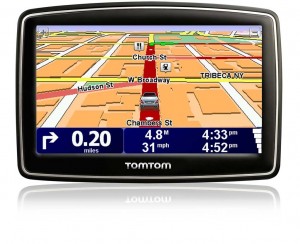
What recession? Despite the sluggish economy, sales of portable "navis" will top 19 million this year, another record.
In the carefully controlled aisles of the typical Costco superstore, one of the first things you’re likely to run into is a display for the portable navigation systems. Plug one in, stick it onto your windshield and you’ll never get lost again, or so claim manufacturers like Garmin, Magellan and TomTom.
The technology has come a long way over the last quarter century. The first commercial system, the Etak Navigator, required a half-dozen cassette-like data tapes to map a city the size of San Francisco. Today’s “navi” unit is likely to cover the entire U.S. and Canada on a thumbnail-size memory chip. And more and more of the devices are adding features like real-time traffic alerts, weather and a Bluetooth cellphone link.
Yet prices have plunged; from an average of $1,000 or more, early this decade, many models now come in at least than $200.
So, it’s perhaps no wonder that as an otherwise dreary 2009 comes to a close, industry analysts are forecasting that American consumers will have purchased a record 18 million portable navigation devices, up from the previous record, the 17.3 million sold last year.
That’s actually a bit of a surprise, admits Tom Murray, vice president of market development for TomTom, one of the trio of best-selling portable navi manufacturers. “We’re still impeded by the economy,” he tells TheDetroitBureau.com, suggesting “it should have been north of 20 million.”
Navi devices have, in fact, been the fastest-growing category ever in the consumer electronics industry, according to the trade group, the Consumer Electronics Association.
The rapid growth of the portable technology stands in sharp contrast to demand for built-in navigation technology, which is still being ordered by just a little more than 10% of the American car buying public. While “consumers are willing to open their wallets” for the technology, they’ll only dig so deep, cautions Steve Koenig, a CEA researcher.
Factory-equipped systems are generally priced over $1,000, with most makers asking anywhere from $1,200 to more than $2,000 – though built-in systems do have some advantages, even after-market makers, like TomTom acknowledge. Among other things, their screens can be used to operate a variety of other in-car technologies, such as climate control, audio and even seating.
But in other ways, auto manufacturers are the ones continually playing catch-up, reflecting the fact that development times in the automotive industry can run several years, where lifecycles in the consumer electronics world typically run less than 12 months.
The automakers, “with their lead time and costs for creating built-in solutions just can’t compete,” contends Murray. “We can do things much faster and at a much more affordable cost.”
Ironically, makers like TomTom have found that many of their customers could afford the higher price of a built-in navigation system; but these buyers often have multiple cars, so they prefer to purchase a single portable navi and move it from vehicle to vehicle.
Could there be a way for the two sides to make peace? Renault is one of several makers experimenting with so-called “hybrid” navis, devices that can be plugged into a vehicle, where they gain the additional features of a built-in. But they can be removed and used elsewhere just like a portable navigation systems.
While portables may be what Murray describes as TomTom’s “bread and butter,” he admits that the industry could reach the saturation point where navi systems become almost ubiquitous and demand switches to replacement mode.
But there’s a new market emerging. The latest version of the Apple iPhone can run turn-by-turn mapping “apps,” including AllSport GPS, from Trimble Navigation, at $9.99, which can be used in a car or even while walking. TomTom has launched a more complex package, starting at $99.99.
Where portable navis account for 80% of his company’s current sales, Murray believes “there may be a point in time” when that “flips” and smartphone apps become the major source of revenues, “but I don’t expect that to happen in the next five years.”
While hardware may be the big selling point, the emergence of the smartphone mapping app is likely to shift the battle back to the underlying software. The challenge is to give consumers not just an accurate map, but an intuitive system that helps them plot the best route – in the way they want to travel.
Adding real-time traffic helps, especially when a navi is smart enough to plot a detour automatically. But next-generation systems are going a step beyond. Inrix, a map software supplier, has been building a database that reflects not just the posted speed limit of any given road, but which also recognizes that a freeway can be choked to a crawl at certain times of day.
The latest TomTom devices constantly monitor road conditions and, with an owner’s permission, will download that data to a corporate computer that is constantly revisiting how routes are calculated.
Considering the steady upgrade of the technology, there’s little doubt the navi market will continue to set new sales records for the foreseeable future.
